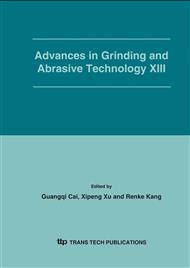p.62
p.66
p.71
p.76
p.81
p.85
p.90
p.94
p.99
Bonds of Electroplated Diamond Tools for Optical Glass Machining
Abstract:
Bonds of electroplated diamond tools are investigated through the studies of microstructures and properties. Three coatings for tool bonds, nickel, nickel-cobalt and bright nickel, were fabricated with electrodeposition processes, and were heat-treated with different temperatures. The hardness and microstructures of coatings were measured and observed. Optical glass K9 was machined with fabricated electroplated diamond tools to compare material removal rate and grinding ratio. The grain sizes of three bond coatings are different. The laminar structures of nickel-cobalt and bright nickel coatings turn to fine columnar structure after heat treatment processes. With heat treatment of 200°C temperature, bright nickel electroplated diamond tool presents highest values of material removal rate and grinding ratio. The research results show that better microstructures and property of bond for electroplated diamond tool can be obtained by selecting proper electroplating technology and heat treatment processes.
Info:
Periodical:
Pages:
81-84
Citation:
Online since:
February 2006
Authors:
Keywords:
Price:
Сopyright:
© 2006 Trans Tech Publications Ltd. All Rights Reserved
Share:
Citation:


